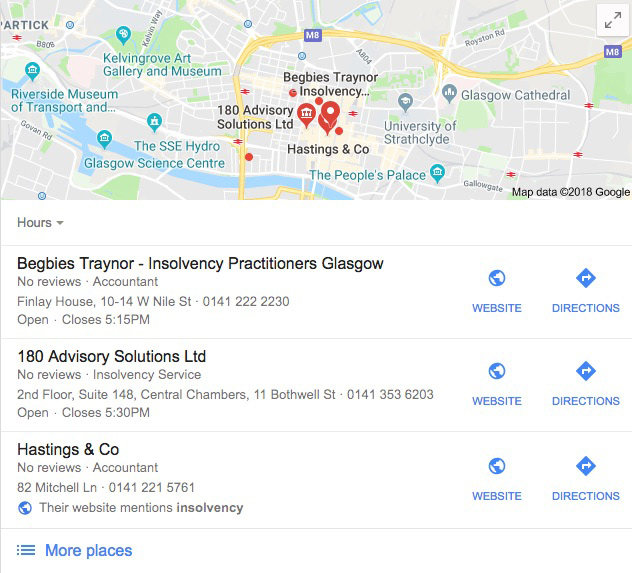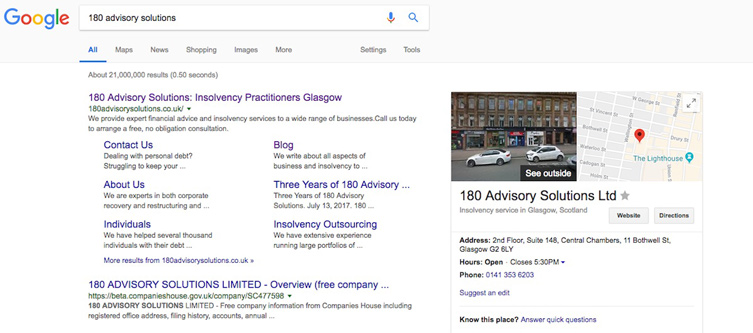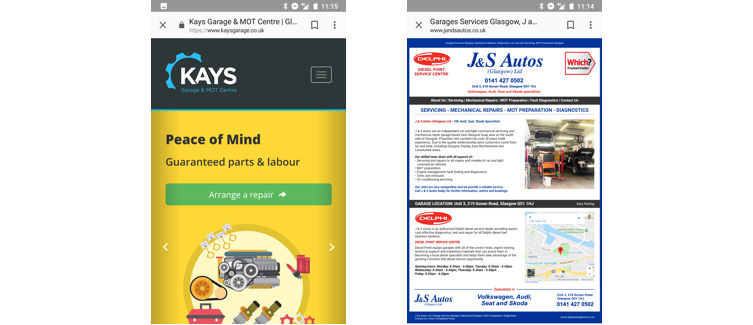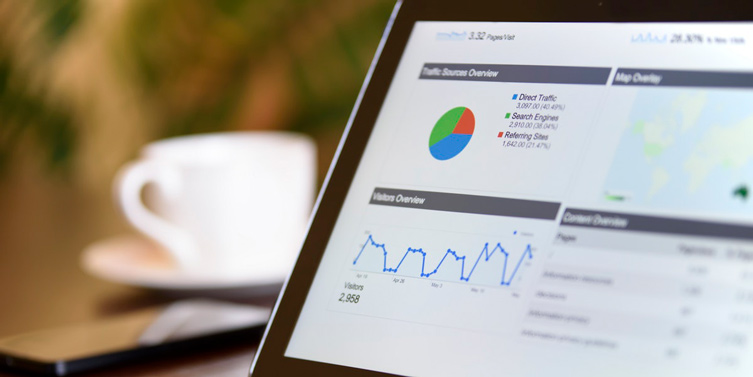If you want a chance of rising to the top of the first Google results page, you need to put in some hard graft.
But what is local SEO, and how important is it for your search rankings?
Local SEO is SEO on a micro-scale. It optimises your website for rankings in a particular geographical location, rather than competing with businesses nationally, or even globally, which is irrelevant for attracting local customers.
Fine-tuning your local SEO efforts will bump your business up the organic listings and will earn it a spot in Google’s “map pack”, a condensed list of the details and location of the top 3 most relevant businesses for the searched term.
Here’s an example of a map pack for the term “insolvency glasgow”.

Mobile users look for solutions on-the-go. Using local SEO, you can give these potential customers what they want, when they want it.
Local SEO is a data-driven process that is cheaper and more effective than traditional marketing, allowing you to generate statistics which show you the concrete impact of your efforts.
Ready to get started with your own local SEO strategy? Here are some expert tips from a digital agency for out-ranking your competitors!
Keyword Research
Crucial to SEO is your choice of keywords.
You can’t expect to rank for any old list of words you’ve plucked from thin air. They need to be words that your target customers are actually searching for and are relevant to your business.
But how do you work out what these keywords are?
Google Keyword Planner
You need to familiarise yourself with Google Keyword Planner (GKP).
Think of a list of keywords related to your business and load them into the planner. GKP tells you the search volume and competition for each word you enter. It’ll also give you suggestions for similar words you might want to consider.
This information will indicate how worthwhile it is targeting certain keywords and notes how difficult it will be to overpower your competition.
Competitor Keywords
You can also take guidance from your competitors.
Pop a competing website’s URL into GKP and you’ll be met with a list of relevant keywords.
Use relevant suggestions in your overall strategy to drive their potential traffic towards your site!
Long-Tail Keywords
It is unlikely that your customers are searching for one or two-words. If they are looking for an immediate solution to their problems, they are likely to enter a longer, more precise search term into Google to get more specific, relevant results. This is called a “long-tail” search.
If you pursue long-tail keywords, you’ll be able to catch consumers who are already further through the conversion tunnel, ready for your services!

Google My Business
This platform is vital to make use of if you’re a local business. On your business profile will be important information for potential customers to find out who you are, what you do, and where to find you.
It’s the only way you can claim ownership of your business and take full control of information on the business listing, otherwise anyone can edit the listing! All this information is used by Google to determine rankings and the map pack chosen 3.

Your Google My Business profile is important for building trust with your potential customers and for signalling your authority to Google.
You can’t just go filling out the fields haphazardly. There is a knack to taking full advantage of your profile.
Once you’ve registered your business and verified your ownership, you need to make sure your profile is packed with all of the necessary information and it needs to be 100% accurate!
Categorisation
You’ll need to categorise your business properly. Categorise your business as extensively as you can without picking irrelevant groups.
If you’re a law firm, select categories corresponding to the different types of law you specialise in, but don’t click any that you can’t cater for in a bid to catch potential customers searching for different terms. This wastes their time because you’re not a good match for them, and as your bounce rates increase your rankings are likely to do the opposite: drop.
Google is very clever and will know what you’re up to, and your business listing will be penalised for it.
NAP
Sit down and work out exactly what your “NAP” details are - name, address, phone number.
What is the proper spelling of your business name? What is your full, specific address? What is your main phone number?
This exact information is what you must use on every public listing of your business, so get it right here!
Precise NAP details communicates to potential customers that you’re legitimate and trustworthy, and Google is able to use the data to determine your search ranking.
Other useful information like your opening hours, a link to your website, and a short bio to tell people what you’re all about are also highly recommended. A full profile shows you’ve put in effort and looks good to Google and your target audience.
Images
Pick an attention-grabbing photo to entice potential customers to look at your listing. If you use a grimy photo of your storefront that was taken on a rainy day, it’s not going to give the best impression.
Whip up a snazzy looking logo or get some great pictures taken with a good quality camera.

While you’re at it, add a few other pictures that represent your business to give potential customers a better insight into what you do. Whether it be menu photos, pictures of staff, or the interior of your premises, it all gives an air of legitimacy to your business.
Unfortunately Google won’t be able to enjoy your pictures so name your photo files with your desired keywords so it understands what they are!
On-Page Optimisation
Google’s search crawlers are going to be looking for your keywords in specific nooks and crannies of your website.
Title Tags
Your keywords should be pride of place in your H1 tags. Placing them near the beginning of the tag will also give you bonus points.
Meta
All your pages and posts should have an informative, relevant, and engaging meta description.
Whilst Google doesn’t really account for this meta information, it provides the snippet of text that appears under your search listing which potential customers will scan through to decide whether to visit your page.
Your meta should be unique to each page or it will look spammy.
Responsiveness
Bearing in mind what we said about mobile users looking for immediate solutions, it really is crucial that your website is responsive across platforms, especially mobile.
If users have to pinch and zoom to make out the text, or half of the words are cut off the screen, then they’re going to lose patience and you’re going to lose their custom!
Your website should look clean and professional on all devices.
Check out these examples below. The first image has a minimalist design and responds to the mobile device by tucking away the menu in the top right corner, easily facilitating the customer journey. The second is just a replica of the desktop site crammed into the tiny mobile screen space - it looks loud, cluttered, and difficult to navigate.

Images
Similar to your Google My Business profile, images are a fantastic way to engage potential customers.
If, however, your image files are so large that your page takes an age to load, then you can guarantee your bounce rates are going to skyrocket.
Nobody likes a page where the images are grainy and if they can’t even navigate your website, they’re definitely going to look somewhere else within seconds!
Optimise your image file size and type so they look good and load quickly.
Citations
A citation is basically a listing of your business on another website which includes your NAP information and sometimes other details.
Google likes citations. The search algorithms use them cumulatively to verify your business information to promote to searchers.
The more consistent citations you have, the stronger they deem the accuracy of the data, the more important you’re deemed, and the higher your rankings.
But don’t wait for these citations to just organically appear!
You can, and should, construct them yourself by submitting your NAP details to online local business directories and local blogs.
If you’re stumped for where to find homes for citations, then do a quick Google search to find out where your competitors have them, and submit to the same sites!
Make sure you keep a close eye on your citations so you don’t end up with hordes of inaccurate listings. If any of your major NAP data changes, you’ll need to go back and edit the lot of them.

Backlinks
Backlinks are links to your website from another website, and they’re considered to be one of the top 3 ranking factors for Google.
Having lots of good quality backlinks can boost your domain authority and boost your rankings.
Don’t go overboard and reach out to every and any blog that will link to you. Google views this as spammy and unnatural, and it’ll harm your rankings. Find sites with high authority that are relevant to your business.
There are some nifty ways for you to generate fruitful local backlinks. Turn your hand at guest posting for other local businesses. Sponsor an event in your local community and have it listed on the local authority’s website. Or write a fantastic, valuable resource page that can be linked to over and over again by other sites in your niche.

Reviews
Reviews can boost your rankings by building credibility and trust with potential customers.
If your current testimony section is looking pretty barren, how can you inject a bit of life into it?
Simple: just ask your customers to leave a review!
Not everyone will, but if you don’t ask, you don’t get!
Once you’ve secured some reviewers, make it easy for them to follow through. Place direct links to your Google Business, Yelp, TripAdvisor, and Facebook profiles in your e-mail signature, on your website, or in your actual physical premises to guide them.
And most importantly, individually thank everyone who leaves a review, good or bad! This shows you care about and you’re engaging with your customers.
But how does this link into local SEO? Well, watch the traffic to your website soar as the reviews flood in!

Track Your Progress
One of the sweetest things about putting time and effort into a project is seeing the outcome. So make sure you monitor your progress!
Tools like Google Analytics and Google Search Console are great for tracking your goals, whether it be increasing your website traffic, the number of contact forms submitted, or appointments generated.
Keep an eye on your website traffic levels, your bounce rate, and traffic referral points to see how you’re getting along.

Ready To Get To Work?
By following these expert tips, your journey to boosting your local SEO will be smooth and effective.
In no time, you’ll see website traffic rapidly increase and this will be reflected in the real-life footfall in your local business.